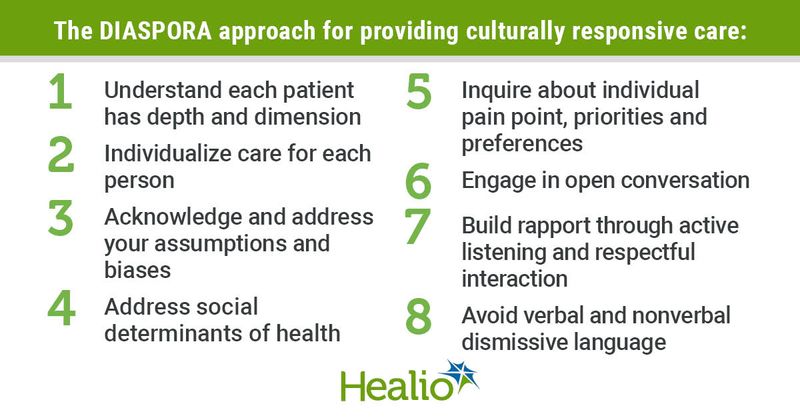Culturally responsive care key for increasing health care engagement with Black community
BALTIMORE — Recognizing Black people with diabetes as distinct individuals and engaging in culturally responsive care is critical for increasing patient engagement in Black communities, according to a speaker.
In a presentation at the Association of Diabetes Care & Education Specialists annual meeting, Kimberly F. Ellis, MSN, FNP-C, CDCES, nurse practitioner and health care consultant for Ellis Diabetes Consulting & Education in Dallas, discussed a series of steps and techniques for increasing engagement with Black patients. The steps involve making each individual patient the center of the provider’s attention and recognizing that each person comes from a different background and has their own concerns and priorities regarding their health.

“Understanding that each patient is an individual with depth and dimension will help you to approach your Black patient as an individual and not just a part of the collective” Ellis said. “We need to change the way we research different groups, the Black population being one of them. We need to change the way that we care, the way we approach Black patients, as well as our language.”
Recognize the African diaspora to improve engagement
Ellis described patient engagement as a core tenant of any medical practice, as effective patient engagement can benefit health outcomes, improve the experience for the patient and the staff and reduce costs. To achieve patient engagement, providers must be patient-centered and culturally responsive.

The need for engagement is especially critical for Black adults with diabetes to address medical distrust. In a poll conducted in October 2020, about 70% of Black respondents said they were being treated unfairly by the health care system, and 55% said they distrust the system. This mistrust leads to lower likelihood of acting on medical advice, attending follow-up appointments or filling prescriptions.
Ellis said providers should realize the Black community includes more than African Americans. She said the African diaspora, or a scattered population whose origin lies in separate geographic locales, includes Africans, African Americans, Afro-Caribbeans and Afro-South Americans.
“Our literature, our research, our language has to take into account that the Black community is a part of a diaspora,” Ellis said. “We are coming in with multiple influences and cultures from all over the world.”
Adopting the DIASPORA approach
Ellis presented the DIASPORA approach, which includes eight key components for improving provider-patient engagement for delivering diabetes care to the Black community. DIASPORA is an acronym that stands for dimensional, individualize, address assumptions, social determinants of health, pain points, open conversation, rapport and avoid dismissal.
In being dimensional, providers are tasked with understanding that each patient is an individual with depth and dimension. Individualizing care involves producing a care plan centered on the specific patient rather than the population they are part of. To address assumptions, providers should acknowledge and eliminate biases toward a specific demographic. Social determinants of health are a key component that providers — and all parts of society — must recognize and address, according to Ellis.
“Assessing where people spend the majority of their time, knowing that it will affect largely their health outcome, we have to address this,” Ellis said. “Addressing social determinants of health appropriately is fundamental for improving health and reducing long-standing inequities in health, which requires action by all sectors and civil society.”
The component “patient pain point” signals that providers should identify what is most important to each individual patient. Open conversation is a component that involves a form of motivational interviewing through the use of open questions, affirmation, reflection and summarization. Establishing rapport is crucial for people who are disadvantaged or marginalized because it is the most effective way of building trust.
“Being in the community is one of the best ways to build rapport,” Ellis said. “People need to see you. You can’t just be the clinic on the corner. Are you going to the community events? Do you set up a booth at community events? Are you meeting with the leaders in the community?”
Avoiding dismissal is about staying away from dismissive language, something that Ellis said providers can communicate both verbally and nonverbally.
“Recognition is how you avoid dismissal,” Ellis said. “I see you, I hear you, I believe you. We have to realize there’s power in our tongue. We have to really come from a place where we can break down our patient.”

